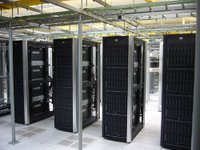Amazon EC2: The Potential
 Amazon's Elastic Compute Cloud (EC2) is easily their most powerful web service offering. With EC2, you get flexible, on-demand computing resources: by launching an instance you get full access to a brand-new machine and its resources. Each CPU-hour costs $0.10, which equates to less than $80 per month if you run an instance 24/7! What's more, you can launch as many instances as you'd like so you can have your own network of machines hosted by Amazon. The clincher? All data transferred between EC2 instances and S3 is free!
Amazon's Elastic Compute Cloud (EC2) is easily their most powerful web service offering. With EC2, you get flexible, on-demand computing resources: by launching an instance you get full access to a brand-new machine and its resources. Each CPU-hour costs $0.10, which equates to less than $80 per month if you run an instance 24/7! What's more, you can launch as many instances as you'd like so you can have your own network of machines hosted by Amazon. The clincher? All data transferred between EC2 instances and S3 is free!The default configuration has the following specs:
- CPU: 32-bit, 1.0-1.2 GHz Opteron/Xeon equivalent
- RAM: 1.7 GB
- Disk: 160 GB
- NIC: 100 MBit
They have additional configurations if you need more resources on a single machine. For details, see the EC2 site. To make all of this work, EC2 allocates a virtual machine running on the Xen hypervisor instead of a physical machine for every instance launched.
Amazon designed EC2 primarily to perform many computationally expensive operations - something like batch video encoding or image recognition. Instead of making large hardware investments to perform these (potentially one-shot) tasks, you run the tasks in parallel on a few (hundred?) EC2 instances. Once the tasks are complete, just shut down the instances and your billing stops there. While Amazon's vision for EC2 is pretty sweet, the reality is that there's so much more potential there.
EC2 is the next-generation data center.
Instead of doing capacity planning as with a traditional data center, with EC2, I could monitor the load on my server and programmatically launch parallel instances once it reaches a threshold utilization. When the utilization drops again, I can terminate the extra instances and go back to a fairly quiescent state. With free traffic between EC2 and S3, I can churn through collected data as many times as I need to as in Amazon's vision. Amazon could even issue hardware updates (e.g. more RAM) to running instances without rebooting! With the inexpensive per-hour prices, any small business can afford to keep an active standby. The flexibility offered by programmatically managing machines running in a virtualized data center is tremendous. Coupled with Amazon's pricing model, this sort of service is poised to take some serious market share away from the traditional, physical data centers.
While EC2 has the potential to be all of this and probably much more, it's not currently ready to displace traditional data centers. In a subsequent post, I'll discuss some of the issues preventing EC2 from realizing this dream.

1 Comments:
Can you tell me how do you add more hardware to your instance while it is running. A specific case is to add an extra NIC to a running AMI.
By Anonymous, At
June 2, 2009 9:26 AM
Anonymous, At
June 2, 2009 9:26 AM
Post a Comment
Links to this post:
Create a Link
<< Home